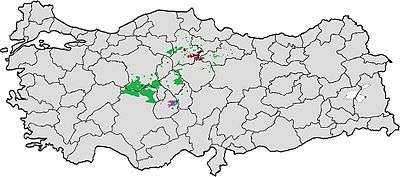Kurds of Central Anatolia
| Total population | |
|---|---|
| 50.000-100.000 | |
| Regions with significant populations | |
| Central Anatolia (Turkey) | |
| Languages | |
|
Kurdish (Kurmancî, Şexbizinî, Zazakî) Turkish | |
| Religion | |
| Islam (Sunni, Alevi) | |
| Related ethnic groups | |
| Kurd, Kurds in Turkey, Kurds of Khorasan |

The Kurds of Central Anatolia[1] (Kurdish: Kurdên Anatolyayê/Anatolê, Turkish: Orta Anadolu Kürtleri[2] or İç Anadolu Kürtleri[3] are the Kurdish people who have immigrated and been in Central Anatolia (present day Aksaray, Ankara, Çankırı, Çorum, Eskişehir, Karaman, Kayseri, Kırıkkale, Kırşehir, Konya, Nevşehir, Niğde, Sivas, Yozgat provinces) since about 16th century.[4][5]
The core of the Kurds of Central Anatolia is formed by Tuz Gölü Kürtleri (Kurds of Lake Tuz) who live in Ankara, Konya and Aksaray provinces.[6] Mustafa Kemal (Atatürk) mentioned them as "Konya çöllerindeki Kürtler" (Kurds in the Konya deserts) in the interview with Ahmet Emin (Yalman) dated January 16/17, 1923.[7]
History
The first Kurdish tribe that arrived at Central Anatolia is Modanlı tribe. They settled in Haymana in 1184[8] and spread to not only different places of Central Anatolia but also to Hasha-i İstanbul and Rumeli: Aksaray, Kütahya, Rumeli, Çatalca, Koçhisar, Haymana, Ipsala and Evreşe. And Modanlı tribe belonged to Merdisi tribe.[9] The first Central Anatolian Kurdish village named Kürtler (Kurds) was founded in Yaban Âbâd (present day Kızılcahamam-Çamlıdere, Ankara) in 1463.[10]
According to Mark Sykes, the first Kurdish exile to Central Anatolia was carried out during the reign of Selim I (1512–1520).[11]
According to Hermann Wenzel, the original breeders of the Angora goat were these Kurdish people of Inner Anatolia.[12][13]
Tribes
The largest tribes of the Kurds of Central Anatolia are the Bazaini or Shaikh Bazaini, Judikan, Saifkan, Chelebi, Janbeki, Jehanbegli, Khallikan, Mutikan, Hajibani, Barakati, Badeli, Ukhchizhemi, Rashvan, Sherdi, Urukchi, Milan, Zirikan, Atmanikan, and Tirikan. Formerly, some of the Janbegli were of Yazidi origin and followed Yezidism.[14]
There are also many Kurds who are not connected with any tribes.
Languages
Two or the four primary dialects of Kurdish are used by the Central Anatolian Kurds. These are Kurmanji and Dimili/Zaza. Generally, their mother languages are Kurdish (Kurmanji) and Kurmanji-speaking people have difficulty to understand the language spoken in Haymana where Şeyhbızın (Şêxbizinî) tribe members live.[15] It is said that the new generation of Kurdish people in some settlements no longer speak Kurdish.[16]
Notable figures
- Hatice Yaşar, Xace Xan; politician, writer, founder of the Kurdish resistance organisation Ala Rizgari (the flag of freedom), and women's rights activist of Shexbizeni tribe.
- Burhan G, musician, Shexbizeni tribe.
- Prof. Dr. Ömer Özkan (who made simultaneously the first face and limbs transplantation operation in Turkey). Shexbizeni tribe.
- Ömer Kart (one of the founders of National Party, deputy of the Republican National Party).
- Musa Kart (Ömer Kart's son, caricaturist)
- Vedat Yıldırım (one of the soloist singers of Kardeş Türküler)
List of villages
Villages of Aksaray
| Village [17] | Ethnic group |
|---|---|
| Akin | Kurmanj |
| Alayhan | Kurmanj/Dimily |
| Babakonağı | Kurmanj |
| Bebek | Kurmanj |
| Borucu | Dimily |
| Büyük Pörnek | Kurmanj/Dimily |
| Cami | Kurmanj |
| Cankilli | Dimily |
| Çavdarlı | Kurmanj |
| Çalı Bekir | Dimily |
| Çekiçler | Dimily |
| Çolaknebi | Kurmanj |
| Düğüz | Kurmanj |
| Ekecikgödeler | Dimily |
| Ekeciktolu | Dimily |
| Ekecikyeni | Dimily |
| Fatmauşagi | Kurmanj |
| Gökkaya | Kurmanj |
| Göksugüzel | Kurmanj |
| Kalebalta | Kurmanj |
| Karaçayir | Dimily |
| Karakova | Kurmanj |
| Karakuyu | Dimily |
| Koyakköy | Dimily |
| Küçükpörnek | Dimily |
| Macir | Kurmanj |
| Macarli | Kurmanj |
| Kışla Sor | Kurmanj |
| Reşadiye | Kurmanj |
| Sağırkaraca | Kurmanj |
| Salmanli | Dimily |
| Sarıağı | Kurmanj |
| Susadi | Kurmanj |
| Şeyhler | Dimily |
| Taptuk | Dimily |
| Tepesidelik | Kurmanj |
| Yalnizceviz | Kurmanj |
| Yanyurt | Dimily |
Resources
- ↑ Ingvar Svanberg, Kazak refugees in Turkey: a study of cultural persistence and social change, Academiae Ubsaliensis, 1989, ISBN 978-91-554-2438-1, p. 28. (English)
- ↑ Rohat Alakom, Orta Anadolu Kürtleri, Evrensel Basım Yayım, 2004, ISBN 975-6525-77-0. (Turkish)
- ↑ Nuh Ateş, İç Anadolu Kürtleri-Konya, Ankara, Kırlşehir, Komkar Yayınları, Köln, 1992, ISBN 3-927213-07-1. (Turkish)
- ↑ Rohat Alakom, ibid, p. 14. (Turkish)
- ↑ Ayşe Yıldırım, Ç. Ceyhan Suvari, İlker M. İşoğlu, Tülin Bozkurt, Artakalanlar: Anadolu'dan etnik manzaralar, E Yayınları, ISBN 975-390-205-0, p. 166. (Turkish)
- ↑ Müslüm Yücel, "Tuz Gölü Kürtleri", I-VIII, Yeni Gündem gazetesi, 2000, İstanbul. (Turkish)
- ↑ Atatürk'ün bütün Eserleri, Kaynak Yayınları, Cilt: 14, ISBN 975-343-400-6, pp. 273-274. (Turkish)
- ↑ Rohat Alakom, ibid, p. 33. (Turkish)
- ↑ Cevdet Türkay, Başbakanlık Arşiv Belgelerine Göre Osmanlı İmparatorluğu'nda Oymak, Aşiret ve Cemaatler, Tercüman Yayınları, 1979, p. 502. (Turkish)
- ↑ Ahmet Nezili Turan, Yaninâbâd Tarihini Ararken, Kızılcahamam Belediye Yayınları, 1999. (Turkish)
- ↑ Mark Sykes, "The Kurdish Tribes of the Ottoman Empire", The Journal of the Royal Anthropological Institute of Great Britain and Ireland, Vol. XXXVIII, 1908.
- ↑ Hermann Wenzel, Sultan-Dagh und Akschehir-Ova, Kiel, 1932. (German)
- ↑ Hermann Wenzel, Forschungen in Inneranatolien II: Die Steppe als Lebensraum, Schriften des Geographische institut Kiel, VII, 3, Kiel, 1937. (German)
- ↑ Rohat Alkom, ibid, p. 63. (Turkish)
- ↑ Peter Alford Andrews, Türkiye'de Etnik Gruplar, ANT Yayınları, Aralık 1992, ISBN 975-7350-03-6, s. 155.
- ↑ Dr. Mikaili, "Devlet Kürtçe'ye Kapıları Açtı, Ya Biz Orta Anadolu Kürtleri ? ", Bîrnebûn, Sayı: 45, Bahar 2010, ISSN 1402-7488
- ↑ "Diaspora: Die Kurden in Aksaray". Kurdica (in German). 2 September 2008. Retrieved 4 May 2016.
See also
External links
- Bîrnebûn
- Veger
- Kurdên Kirşehîrê (Kurdish / Turkish)
- Asemblee Parlementaire, Documents De Seance: Session Ordinaire D'octobre 2006